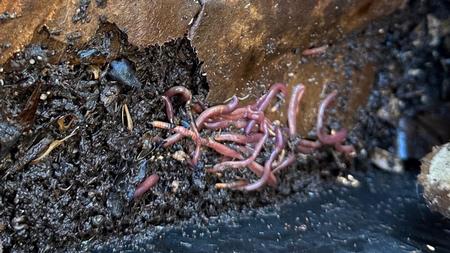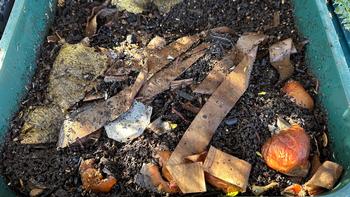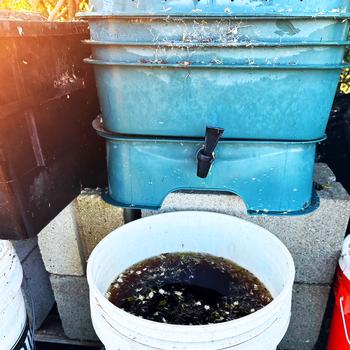News from the Edible Demo Garden
January 2023: Welcoming Worms

The worms that are best for producing compost are the redworms or red wigglers. Marty Nelson
Finding earthworms when turning over soil in the Edible Demo Garden beds is a cause for celebration. Earthworms gravitate to improved soil, so their appearance is an indication that the soil is healthy and is providing the food and moisture that the worms like. The worms then do their job and help create the conditions that produce vigorous plants. They do this by aerating the soil and breaking down decaying organic matter into plant nutrients. It turns out that worm poop, more formally known as castings, makes an excellent organic fertilizer.
Not all the worms in the Edible Demo Garden hang out in the garden beds. There are captive worms living in a specially designed worm bin. These worms are turning cardboard, paper, and discarded produce into compost, or more specifically, vermicompost. The practice of raising worms to make compost is known as vermiculture. Because these worms are not free to roam the garden, they need a regular supply of food, sufficient moisture, and protection from temperature extremes. Worms can eat their own weight each day. When fed regularly, captive worms can survive year around in a cool, shady spot in Marin’s temperate coastal climate,
Are all earthworms the same?

Newspaper or cardboard provides a carbon source and kitchen scraps a nitrogen source for a worm bin. Marty Nelson
There are thousands of earthworm species, but the two most common garden types are the night crawlers,
Lumbricus terrestris and the redworms or red wigglers,
Eisenia fetida. The night crawlers are larger and burrow deeply into the ground creating tunnels that help air, water, and plant roots move through the soil. The smaller red wigglers dwell near the soil surface, feeding under leaf litter. As surface dwellers, red wigglers are the species best suited for vermiculture.
Maintaining a worm friendly garden
Good garden practices are also good for earthworms. Regular additions of compost and mulch provide food and protection for plants and worms. Both thrive in soil that is moist but not soggy or too dry. Also, like plants, earthworms prefer fertile soil with a pH between 6.0 and 7.0 so the same organic amendments benefit both.

A worm bin operates in layers with the bottom layer collecting the liquid from the decomposition process. This liquid can be used to water the garden.
Although earthworms are important in the food chain and fall prey to birds, small mammals, reptiles, and insects, their two biggest threats are pesticides and cultivation. Commonly used pesticides, even some organic pesticides, can be lethal to earthworms if allowed to contaminate the soil. Soil cultivation presents another dilemma for gardeners. It’s good practice to avoid turning over the soil as much as possible, yet even minimal tilling can result in earthworm casualties. Contrary to common belief, earthworms cannot easily grow replacement parts or regenerate from pieces. Studies have shown a negative correlation between the frequency of cultivation and the number and size of earthworms in the soil.
Why raise worms?
Historically, worms were not always appreciated. Charles Darwin is credited with bringing attention to their abilities and usefulness. Raising worms can be an interesting hobby with benefits. As pets, they are quiet and undemanding and when properly cared for, they don’t smell. They dispose of unwanted food scraps and produce compost that can improve the quality of edible crops. There is a seasonal sequence to their work and if they overpopulate the worm bin, they can be set free in the garden.
Watch below for instructions on how to make a worm bin, from the Marin Master Gardeners YouTube Channel!



